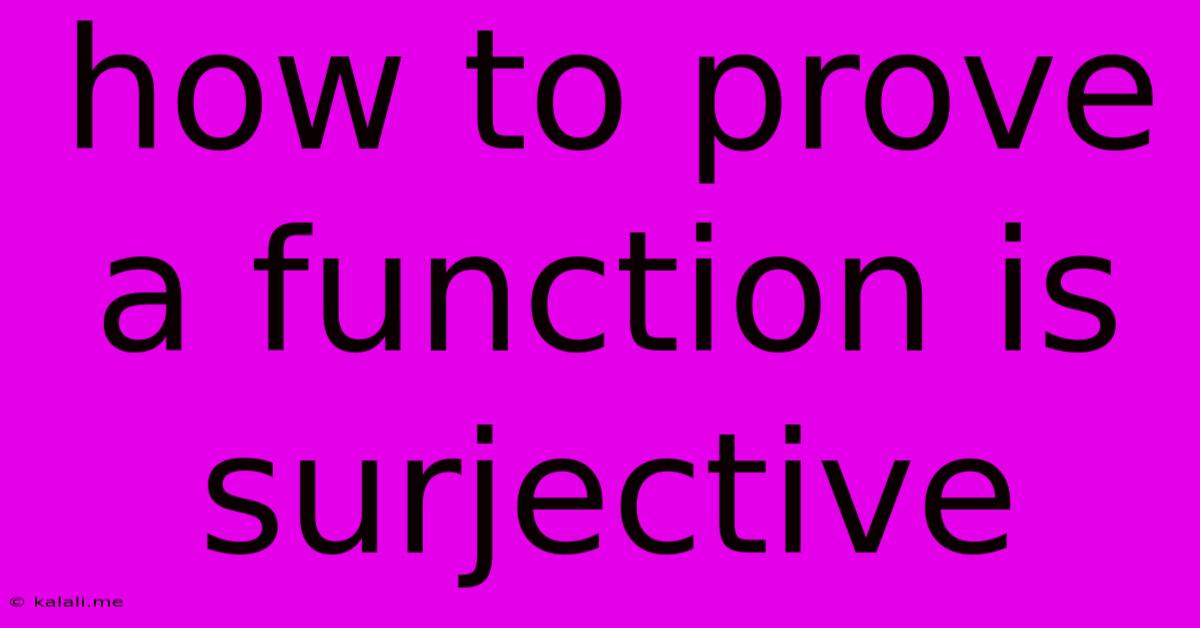How To Prove A Function Is Surjective
Kalali
May 25, 2025 · 3 min read

Table of Contents
How to Prove a Function is Surjective (Onto)
This article will guide you through various methods for proving a function is surjective, also known as onto. Understanding surjectivity is crucial in various areas of mathematics, including calculus, linear algebra, and abstract algebra. A function is surjective if every element in the codomain has a corresponding element in the domain that maps to it. In simpler terms, the function's range equals its codomain. Let's explore how to rigorously demonstrate this property.
Understanding Surjectivity: A Quick Recap
Before diving into proof techniques, let's solidify our understanding of surjectivity. A function f: A → B is surjective if for every element y in the codomain B, there exists at least one element x in the domain A such that f(x) = y. This means the function "covers" the entire codomain. The opposite is an injective function (one-to-one) where each element in the codomain maps to at most one element in the domain. A function can be injective, surjective, both (bijective), or neither.
Methods for Proving Surjectivity
There are several approaches to demonstrate surjectivity, each suited to different function types and complexities.
1. Direct Proof: This is the most straightforward method. You directly show that for an arbitrary element y in the codomain, you can find an x in the domain such that f(x) = y.
-
Steps:
- Start with an arbitrary element: Begin by stating "Let y ∈ B (where B is the codomain)."
- Find a pre-image: Solve the equation f(x) = y for x. This will express x in terms of y.
- Show existence: Demonstrate that the x you found is indeed in the domain A.
- Conclude: State that since you've found an x for any arbitrary y, the function is surjective.
-
Example: Prove that f(x) = 2x from ℝ to ℝ is surjective.
Let y ∈ ℝ. We need to find an x ∈ ℝ such that f(x) = y. Solving 2x = y for x, we get x = y/2. Since y is a real number, y/2 is also a real number, meaning x ∈ ℝ. Therefore, f(x) = 2x is surjective.
2. Proof by Cases: If the function's domain or codomain is partitioned into distinct subsets, a proof by cases can be effective. You demonstrate surjectivity for each subset separately. This is useful when dealing with piecewise functions or functions with domain restrictions.
3. Using Properties of Functions: If your function possesses specific properties, you can leverage them to prove surjectivity. For example, if you can show that your function is the inverse of a known surjective function, then your function is also surjective.
4. Contrapositive Proof: While less common for directly proving surjectivity, a contrapositive proof can be useful in certain scenarios. Instead of proving that for every y there exists an x, you prove that if there's no x, then there's no such y.
5. Graphical Method (For Simple Functions): For functions with easily visualized graphs (e.g., simple polynomial functions), a graphical method can provide intuitive proof. If every horizontal line intersects the graph at least once, the function is surjective. However, this is not a rigorous mathematical proof and should be supplemented with a formal algebraic proof, especially for complex functions.
Common Mistakes to Avoid
- Confusing surjectivity with injectivity: Remember that surjectivity and injectivity are distinct properties. A function can be one, the other, both, or neither.
- Not considering the entire codomain: Ensure you address every element in the codomain during your proof. Failing to do so is a common error.
- Incorrectly solving for x: Ensure your algebraic manipulations are correct when solving f(x) = y for x.
- Ignoring domain restrictions: Consider any domain restrictions when determining the existence of an x in the domain A.
By understanding these methods and avoiding common pitfalls, you'll be well-equipped to tackle a wide range of surjectivity proofs and deepen your understanding of this fundamental concept in mathematics. Remember, practice is key. Work through various examples to build your confidence and mastery of this important topic.
Latest Posts
Latest Posts
-
How Much Is 10 Quarters In Dollars
Jul 06, 2025
-
How Do You Beat Stage 9 On Bloxorz
Jul 06, 2025
-
What Is 1 2 Equivalent To In Fractions
Jul 06, 2025
-
How Do You Say Pork In Spanish
Jul 06, 2025
Related Post
Thank you for visiting our website which covers about How To Prove A Function Is Surjective . We hope the information provided has been useful to you. Feel free to contact us if you have any questions or need further assistance. See you next time and don't miss to bookmark.